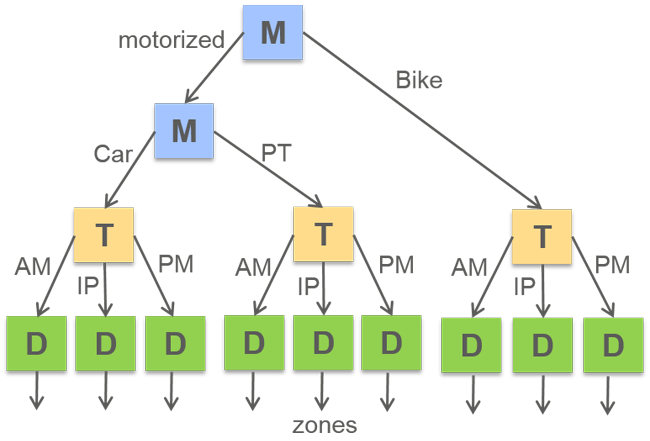The ‘Nested demand’ model is an extension of the standard 4-step model for demand calculation. The calculation is based on a nested logit model, in which the destination choice (D), mode choice (M) and choice of time of day (macro time period) (T) are arranged in random order within a model structure. A model structure does not necessarily have to include all choices. The hierarchical arrangement within the model structures reflects the responsiveness of persons of a demand stratum to available alternatives. An example of a model structure is illustrated in Illustration 54, which shows the choice of destination, time of day and mode from bottom to top. In addition, the mode choice itself is nested at the top. The alternatives, on the lower level of mode choice, must consist of modes defined in the demand model.

Illustration 54: Example of a model structure with 4 levels (M-> M-> T-> D)
This procedure for demand calculation has the following characteristics:
- It is a general procedure for demand calculation, which can include the choice of destination, mode and time of day in any order. If the choice of destination is not part of the model structure, it is assumed that it has already taken place and the model is only needed for the subsequent steps.
- Model structures can be defined separately for each demand stratum.
- The mode choice can be arbitrarily nested within itself.
- Logsums are calculated and passed on in hierarchical order, from bottom level to top, and can be output optionally for each level.
- The procedure can be used to calculate the demand in absolute or incremental form. The 'absolute' form is an entirely new calculation of the demand. It is based on the productions and attractions that must be calculated first through trip generation. The incremental form, on the other hand, requires utility changes and a base demand to determine the resulting changes in demand.
- For demand strata, you can distinguish between singly or doubly-constrained when choosing a destination. With a doubly-constrained destination choice, you may optionally allow multiple demand strata with the same destination potential (e.g. jobs) to use this potential jointly.
- The demand calculation can either be performed for the outward and return trip or for one trip only. In the first case, a 1 is entered in the result matrix for two paths: for the path from the origin zone to the destination zone and the path from the destination zone to the origin zone.
|
Note: In the directory C:\Users\Public\Documents\PTV Vision\PTV Visum 2025/Examples, you can find an example of use on this topic. The Demand Nested Logit example shows the demand calculation based on a nested demand model. In addition, instructions for modeling and designing the model are provided. |

